Designing Your Garden: Mapping & Planning Your OER
Assessment Mapping
Karna Younger and Theresa Huff
Learning Objectives
- Identify objective-aligned summative assessments
- Identify objective-aligned practices and interactivity (formative assessments)
In Deliverables 1 and 2, you identified the desired results of the instruction (your objectives). The second stage of Backward Design (Wiggins, & McTighe, 2005) is to determine what evidence you will accept to show that learners reached those results. Now that you have planned what information (content) you plan to provide your learners in the OER, it’s time to think about what instruction you might want to include in your OER to help scaffold your learners toward the learning objectives.
What’s the difference between information and instruction? Information is the collection of organized facts, procedures, and examples, which you mapped out in the previous section. Instruction includes practice of and feedback on the information (Wiley, 2021).
| Vertebrae | Spine | Skeleton | Muscle | Systems |
| Objectives are the vertebrae of your OER. | Organized objectives become the spine of your OER. | The Table of Contents acts as a skeleton for your OER. | The Content you create or revise adds muscle to the skeleton of your OER. | The Assessments you add are the systems that make your OER work. |
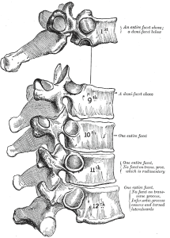 |
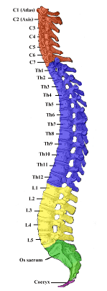 |
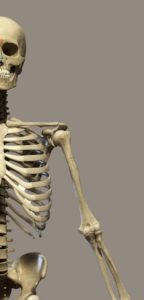 |
 |
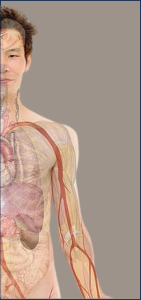 |
Thoracic Vertebrae by Unknown Author, used under CC BY-SA 4.0 and Vertebral column – colored by Henry Vandyke Carter, used under CC BY-SA 4.0. Anatomy, man, human body by Unknown Author, used under CC BY 4.0.
Formative vs Summative Assessments
Summative assessments: these are assessments that measure student’s learning on major objectives. They are usually found in your course.
Example: high-stakes exams, final papers, presentations, created products
Note: These are the end result of the content and instruction you provide in your course.
Formative assessments: these are assessments that measure student’s learning of enabling objectives which help prepare the learners for reaching the major objectives in the summative assessments. They can be found in either your course or in your OER.
Example: low-stakes review quizzes, memorization of key facts, interactive practice
According to Merrill’s First Principles of Instruction (2012), once a learner has been given new information (content), instructors should:
- Allow them to apply the new information on their own. This means letting them practice, make mistakes, and learn from those mistakes.
- Offer ways to integrate the knowledge into the what the learner already knows. This might look like offering opportunities for discussion, reflection, or presentation of the new information.
Gagne, in his Nine Events of Instruction (1965), also states that it is not enough to simply let learners practice with new content without offering immediate and explanatory feedback. Without built-in feedback, learners may be left confused, uncertain, or assume incorrection information.
Formative Assessments in your OER
Depending upon the OER platform you will select, formative assessments (practice, review, and interactivity) can look like interactive videos or simulations, multiple choice review questions, drag-and-drop ordering, and much more. Some OER include tools that support notetaking or reflections of the student as they read and interact with the OER or help the student create things like outlines while they read.
In Chapter 1 and 2 of this Pressbook, you have had the opportunity to try out some of the formative assessment options available using H5P, an interactivity builder that lives in Pressbooks. Chapter 3 will offer more insight into formative assessment you can build in your OER using H5P and other tools.
The goal of this section is to help you design a general plan of what formative assessments and interactivity could be placed within your OER. The actual tool you choose and the building of those formative assessments will come later.
It still starts with your objectives
Just as the learning objectives informs the instructor what content needs to be provided to the learner, the learning objectives also inform the instructor what the summative and formative assessments will be. In this section, you will plan your summative assessments for your course and your formative assessments for your course and/or OER.
Your Turn: Step 1: Start with your objectives
For each chapter or section you have been assigned, begin by looking at the Learning Objectives Covered column of your Table of Contents on the left side of the spreadsheet.
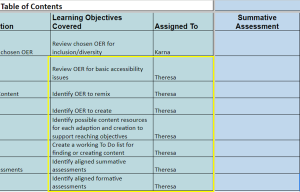
From objective to the end result
You might be wondering why you are being asked to map the summative assessment if it may not be included your OER. In order to identify the best practice and interactivity a learner will need (formative assessment), we have to first identify the ultimate goal for which they are practicing (summative assessment). The summative assessment will measure whether the student has reached the learning objective.
Remember that those measurable, student-centered objectives you worked on for Deliverable 1 inform the instructor what the summative assessment will be.
Objective – Summative Assessment Alignment Example
Learning objective: By the end of this module, students will be able to….
Identify five persuasive writing strategies
- The action verb “identify” tells me what the student will need to do to show they have reached the objective.
- The rest of the objective “five persuasive writing strategies” tells me the context
Knowing that the student needs to “identify” allows the instructor to decide how they want the student to “identify” these strategies. Here are some possible options for the learning objective above:
Possible Summative Assessments: Students will…
- list the 5 strategies from memory.
- look at a group of videos and identify which video is using which strategy.
- write a paragraph that includes listing the 5 strategies.
What’s This Tool? – H5P Single Choice Set
In your team’s OERFSJ Deliverables 1-5 spreadsheet, scroll to the right to find the OER Assessment Map section. Consider each objective in the Learning Objectives Covered column (in Table of Contents on the left) and determine how the student will demonstrate that learning objective by the end of the week or module in the course. Be as specific as possible. Several of your objectives may be measured in the same place, such as a quiz or presentation. Others may be measured in their own summative assessment. Whichever the case, state a planned summative assessment in the Summative Assessment column.
Note: If you are creating an OER for an existing course, you likely already have your summative assessments planned and created (high-stakes exams, final papers, presentations, etc.). Typically, several objectives are measured within the same summative assessment. You will simply type in those existing summative assessments next to every learning objective it measures in your Summative Assessment column.
Your Turn: Step 2: Identify your summative assessment
Once you have decided how you will ultimately assess an objective, list the chosen method in the Summative Assessment column.
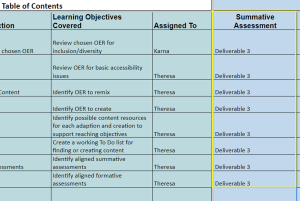
Consider how to scaffold and engage
The learning objective is the starting point. The summative assessment is the end point.
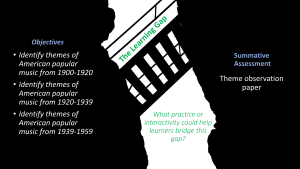
Looking at the learning gap between the learning objective and the summative assessment, consider what Formative Assessments (practices, reviews, etc.) might help the learner prepare for the Summative Assessment you wrote down. Consider also what other interactivities might engage your learner and help them gain a deeper understanding of the learning objective. This might look like using a branching scenario in which a learner has to make decisions based on what they read, an interactive video that requires them to pause and answer reflective questions, or something else.
 Co-creating assessment with students
Co-creating assessment with students
Prof. Rajiv Jhangiani wanted his students to develop a deeper knowledge of social psychology than a multiple-choice test would foster. His answer was to have his students write test questions. Students gradually increasing their content knowledge and learned to formulate multiple-choice questions, submitting four every week. Jhangiani effectively modified his summative assessment for weekly formative assessments that could be used for the summative assessment!
Reflect on how students might learn more by creating assessments. This may involve glowing up your OER with interactive H5P elements. The H5P elements you see in this OER are easy to make and easily shared with a link. The possibilities are endless and may help you scale and scaffold some of your assessment pieces. More to come on open pedagogy.
Objective – Formative Assessment – Summative Assessment Alignment Example
Learning objective: By the end of this module, students will be able to….
Identify five persuasive writing strategies
Summative Assessments: Students will look at a group of videos and identify which video is using which strategy.
Given the learning objective and summative assessment above, ask yourself:
“What does my student need to practice or interact with to prepare them for that summative assessment?”
Possible Formative Assessments:
- List: Students list the five strategies.
- Multiple Answer: From a list that includes the five strategies and three distractors, the student chooses the five strategies.
- Multiple Choice: Students are given a written, audio, or video example and they choose which of the five strategies is being used in the example.
Take another look at the example above, and note these final thoughts:
- Formative Assessments are low-stakes practices. They may or may not be graded. The third formative assessment above could also be used as the summative assessment. The difference is that the formative assessment will likely have several rounds of practice with feedback without grading the student on their performance. The summative assessment would be a high-stakes version of this formative assessment, likely using brand new – but similar – examples.
- Scaffold your formative assessments from easy to challenging. This stair-step approach helps your students slowly increase their understanding, ability, and confidence while maintaining their motivation.
- Whether these assessments are held in your classroom or embedded in your OER, always include immediate, explanatory feedback to the learner.
What’s This Tool? – H5P Single Choice Set
Your Turn: Step 3 – Choose your formative assessments and interactivity
In the Formative Assessments/Interactivity column, for each learning objective list some possible formative assessments and interactivities that would help your learners prepare for the summative assessments.
If possible, state
- the type of interactivity
- “H5P Question Set…”
- where you plan to place it in your OER
- “…placed just after reviewing Workshop 1 content.”
- what the prompt for the interaction might be
- “Match the content to the objective with which it aligns.”
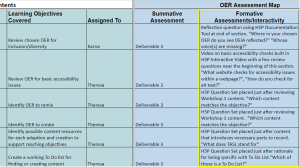
Though you may not use all these formative assessments in your OER, thinking through them now will save you time when you are building these assessments in your OER chapters.
Be kind to your future self
While you have this content and these formative assessments in mind, now is the best time to find examples of what you envision using for your formative assessments and interactivity.
When evaluating examples of assessments to include in your OER, consider the following advice from the BCcampus OER Production Team:
- Use examples that include a variety of people, organizations, geographies, and situations.
- Use real-world scenarios that address diverse situations and contexts.
- Avoid negative stereotypes or sensitive subjects in problems and applications unless the subject matter demands it.
- Do not make assumptions about prior knowledge, especially around culturally specific examples. For example, not all students may be familiar with Western nursery rhymes or kids’ television from the 1990s.
Your Turn: Step 4 – Hunt for Ideas and Examples
Use the resources provided in Chapter 3 and from Workshop 2 to find examples of tools and interactives that would support your formative assessments and interactivity you listed in the Formative Assessments/Interactivity column. Use the Links column as a storage space for links to examples of what you had in mind or to just note that you want to get some ideas from the team.
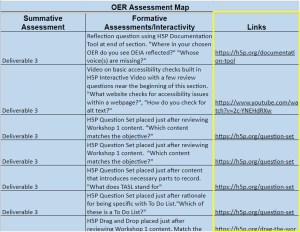
You have now identified what types of formative assessments and interactivities you need for all parts of your OER, where you plan to place those formative assessments and interactivities within your OER, and examples of or links to the interactivity itself. Next, you will begin to consider and gather images, figures, and videos you may use in your OER.
Deliverable 3
Deliverable 3 is the completed OER Content and Assessment Map for all learning objectives.
Once complete, you are ready to upload your OERFSJ Deliverables 1-5 spreadsheet to your team’s OERFSJ Google folder, and email OERFSJ@lmu.edu to let them know your Deliverable 3 is complete.
Resources
BCcampus OER Production Team, “Diverse and Inclusive Representation in OER,” University of Virginia OER Learning Community Guide. Licensed under CC BY 4.0.
Gagné, R.M. (1965). The conditions of learning. New York: Holt, Reinhart & Winston.
Merrill, M. D. (2012). First principles of instruction. John Wiley & Sons.
Wiggins, G., & McTighe, J. (2005). Understanding by design. ASCD.
Wiley, D. (2021, December 10). The difference between an informational resource and an educational resource. Opencontent.org. https: opencontent.org/blob/archives/6892
Licenses and https://opencontent.org/blog/archives/6892Attributions
“OER Content and Assessment Map” by Theresa Huff is licensed under CC BY 4.0.
This is an H5P Single Choice Set. This H5P type allows creators to create sets of questions with only one correct answer.
H5P is a free, open-source interactivity building tool built into Pressbooks. The H5P Hotspot is one of over 50 different types of H5P interactives.
